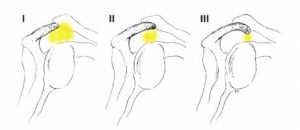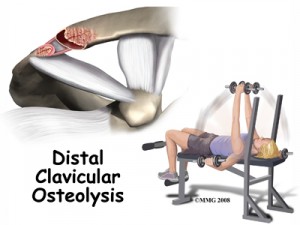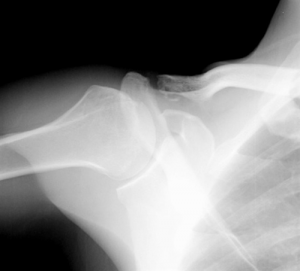This post is a follow-up post to one of my previous ones, A Closer Look at Push-ups & Modified Push-ups, based on some dialogue with a reader. Click the link to familiarize yourself with the background. Some people simply do not agree with my assertion that modifying and or limiting end range of motion with certain exercises such as bench press, push-ups and flies is needed to preserve shoulder health long term.
So many people want to hitch their wagon to “simply strengthen the scapula” as a fix all solution. While I agree 100% that scapular stabilizer and cuff strengthening goes a long way, we would be foolish to ignore joint biomechanics, physics and kinesiology when examining how loads affect joint structure and function over time.
I will start out by saying I ascribe to the idea that a healthy joint should be able to move through full range of motion. My question to you is with how much load and how many times over and over again before destructive microtrauma sets in. With that said, how many healthy shoulder joints do you think are working out in gyms across the world today? Without an x-ray, it is impossible to know if you have a type I (normal), II (flat) or III (hook-shaped) acromion. Your genetics do make a difference in your risk for developing shoulder problems, as types II and III are more prone to impingement (see photos below)

This is one risk factor that cannot be mitigated by prehab if you will. I would also challenge you to consider that loading the shoulder repetitively with heavy loads in the furthest depths of shoulder horizontal abduction (bar touching the chest in bench press or lowering DB’s well below the plane of the body with flies) will eventually create atraumatic shoulder pathology.
Ever wonder about things like:

Click here for an article discussing osteolysis of the clavicle. The authors specifically mention modifying or avoiding certain weight lifting techniques base on pain and radiographic findings. I think we must as fitness professionals, strength coaches and educators look at the long term implications of lifting techniques on long term shoulder health and function.
Most would not hesitate to say they would do anything to avoid shoulder surgery if they knew their exercise habits might pose a risk for a future procedure to alleviate pain and restore function. I firmly believe avid recreational weight lifters and bodybuilders should modify range of motion with many of these pressing and lifting motions to be safe. This includes blocking full range bench press, modifying flies and push-ups, avoiding deep dips and generally minimizing how often they choose to do dips and upright rows. I also feel most people over age 35 or 40 should minimize the frequency of dips and upright rows as risk outweighs reward over time with repetitive loading of the clavicle (particularly if they have a long history of weight lifting already).
Take a look at the x-ray below showing osteolysis. You can often see a widening at the AC joint. Many times, these patients must undergo steroid injections, rest, activity modification and even a distal clavicle excision to resolve the pain.

Call me conservative or crazy, but I know personally how limiting bench press/fly range of motion eliminated my cuff pain in less than 2 weeks years ago when I was in college. Additionally, I currently have two patients in my clinic with shoulder injuries:
So many people want to hitch their wagon to “simply strengthen the scapula” as a fix all solution. While I agree 100% that scapular stabilizer and cuff strengthening goes a long way, we would be foolish to ignore joint biomechanics, physics and kinesiology when examining how loads affect joint structure and function over time.
I will start out by saying I ascribe to the idea that a healthy joint should be able to move through full range of motion. My question to you is with how much load and how many times over and over again before destructive microtrauma sets in. With that said, how many healthy shoulder joints do you think are working out in gyms across the world today? Without an x-ray, it is impossible to know if you have a type I (normal), II (flat) or III (hook-shaped) acromion. Your genetics do make a difference in your risk for developing shoulder problems, as types II and III are more prone to impingement (see photos below)

This is one risk factor that cannot be mitigated by prehab if you will. I would also challenge you to consider that loading the shoulder repetitively with heavy loads in the furthest depths of shoulder horizontal abduction (bar touching the chest in bench press or lowering DB’s well below the plane of the body with flies) will eventually create atraumatic shoulder pathology.
Ever wonder about things like:
- Osteolysis of the distal clavicle
- Anterior shoulder laxity (over stretching the anterior capsule and joint structures over time)
- Creating impingement with repetitive motion in the presence of poor bony architecture, a thickened bursa or inadequate shoulder stability

Click here for an article discussing osteolysis of the clavicle. The authors specifically mention modifying or avoiding certain weight lifting techniques base on pain and radiographic findings. I think we must as fitness professionals, strength coaches and educators look at the long term implications of lifting techniques on long term shoulder health and function.
Most would not hesitate to say they would do anything to avoid shoulder surgery if they knew their exercise habits might pose a risk for a future procedure to alleviate pain and restore function. I firmly believe avid recreational weight lifters and bodybuilders should modify range of motion with many of these pressing and lifting motions to be safe. This includes blocking full range bench press, modifying flies and push-ups, avoiding deep dips and generally minimizing how often they choose to do dips and upright rows. I also feel most people over age 35 or 40 should minimize the frequency of dips and upright rows as risk outweighs reward over time with repetitive loading of the clavicle (particularly if they have a long history of weight lifting already).
Take a look at the x-ray below showing osteolysis. You can often see a widening at the AC joint. Many times, these patients must undergo steroid injections, rest, activity modification and even a distal clavicle excision to resolve the pain.

Call me conservative or crazy, but I know personally how limiting bench press/fly range of motion eliminated my cuff pain in less than 2 weeks years ago when I was in college. Additionally, I currently have two patients in my clinic with shoulder injuries:
- A 19 y/o male hurt doing submax loads full range with a barbell
- A 60 plus y/o male who had arthroscopic repair of a torn supraspinatus that occurred while doing dumbbell flies (submax loads) on a flat bench lowering the dumbbells far below the parallel
Bull NYU Hosp Jt Dis. 2008;66(2):94-101.
Distal clavicular osteolysis: a review of the literature.
Source
Department of Orthopaedic Surgery, NYU Hospital for Joint Diseases, New York, NY 10003, USA.Abstract
Acute distal clavicular osteolysis was first described in 1936. Since then, distal clavicular osteolysis (DCO) has been separated into traumatic and atraumatic pathogeneses. In 1982 the first series of male weight trainers who developed ADCO was reported. The association of weightlifting and ADCO is especially important considering how routine a component weights are to the male athlete's training.
The pathogenesis of DCO has often been debated. The most widely accepted etiology involves a connection between microfractures of the subchondral bone and subsequent attempts at repair, which is consistent with repetitive microtrauma. Symptoms usually begin with an insidious aching pain in the AC region that is exacerbated by weight training. On examination, patients have point tenderness over the affected AC joint and pain with a cross-body adduction maneuver. Although DCO may seem like an easy and quick diagnosis, one must rule out other possibilities.
Avoidance of provocative maneuvers, modification of weight training techniques, ice massage, and nonsteroidal anti-inflammatory drugs (NSAID) constitute the basis of initial treatment. Much of the literature supports the same general indications for surgery. These include point tenderness of the AC joint, evident abnormal signs with AC joint scintigraphy and AC radiographs, lack of response to conservative treatment, and an unwillingness to give up or modify weight training or manual labor. Distal clavicle resection has provided good results. Distal clavicle osteolysis is a unique disease most likely due to an overuse phenomenon.
The pathogenesis of DCO has often been debated. The most widely accepted etiology involves a connection between microfractures of the subchondral bone and subsequent attempts at repair, which is consistent with repetitive microtrauma. Symptoms usually begin with an insidious aching pain in the AC region that is exacerbated by weight training. On examination, patients have point tenderness over the affected AC joint and pain with a cross-body adduction maneuver. Although DCO may seem like an easy and quick diagnosis, one must rule out other possibilities.
Avoidance of provocative maneuvers, modification of weight training techniques, ice massage, and nonsteroidal anti-inflammatory drugs (NSAID) constitute the basis of initial treatment. Much of the literature supports the same general indications for surgery. These include point tenderness of the AC joint, evident abnormal signs with AC joint scintigraphy and AC radiographs, lack of response to conservative treatment, and an unwillingness to give up or modify weight training or manual labor. Distal clavicle resection has provided good results. Distal clavicle osteolysis is a unique disease most likely due to an overuse phenomenon.
- PMID:
- 18537776
- [PubMed - indexed for MEDLINE]